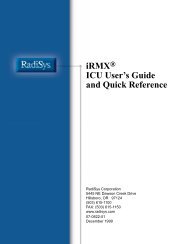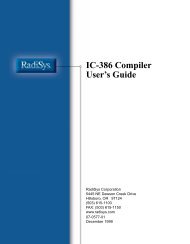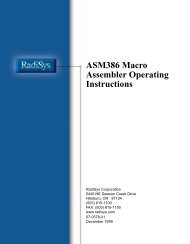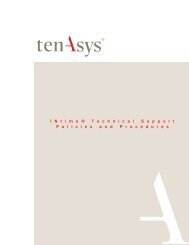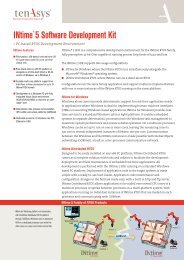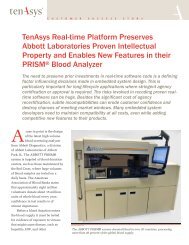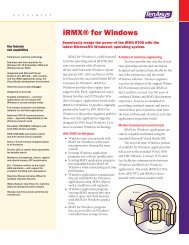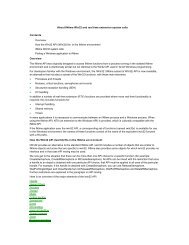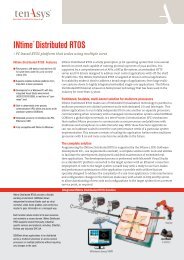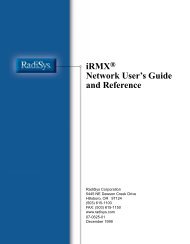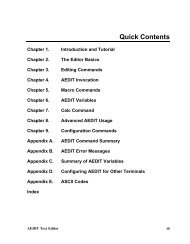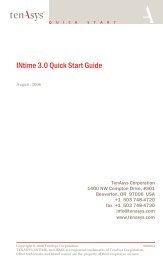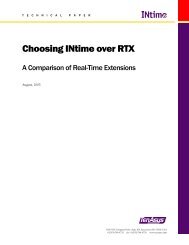- Page 1 and 2: U S E R ’ S M A N U A L INtime ®
- Page 3 and 4: Before you begin This guide describ
- Page 5 and 6: Before you begin Glossary Notationa
- Page 7 and 8: Before you begin • Within source
- Page 9 and 10: Contents Part I Chapter 1 Chapter 2
- Page 11 and 12: Contents Part II Chapter 6 Chapter
- Page 13 and 14: Contents Part III Appendix A Append
- Page 15 and 16: Contents NTX DLLs..................
- Page 17 and 18: I Introducing INtime software This
- Page 19 and 20: 1 Overview INtime software extends
- Page 21 and 22: Chapter 1: Overview Considerations
- Page 23 and 24: Chapter 1: Overview Developing an I
- Page 25 and 26: Chapter 1: Overview INtime software
- Page 27 and 28: Chapter 1: Overview • INtime Grap
- Page 29 and 30: Chapter 1: Overview • Remote conf
- Page 31 and 32: 2 Understanding INtime software arc
- Page 33: Chapter 2: Understanding INtime sof
- Page 37 and 38: Chapter 2: Understanding INtime sof
- Page 39 and 40: Chapter 2: Understanding INtime sof
- Page 41 and 42: Chapter 2: Understanding INtime sof
- Page 43 and 44: Chapter 2: Understanding INtime sof
- Page 45 and 46: 3 About INtime software’s RT kern
- Page 47 and 48: Chapter 3: About INtime software’
- Page 49 and 50: Chapter 3: About INtime software’
- Page 51 and 52: Chapter 3: About INtime software’
- Page 53 and 54: Chapter 3: About INtime software’
- Page 55 and 56: 4 About RT programming This chapter
- Page 57 and 58: Chapter 4: About RT programming Pre
- Page 59 and 60: Chapter 4: About RT programming whe
- Page 61 and 62: Chapter 4: About RT programming Fig
- Page 63 and 64: Chapter 4: About RT programming Syn
- Page 65 and 66: Chapter 4: About RT programming The
- Page 67 and 68: Chapter 4: About RT programming Exc
- Page 69 and 70: Chapter 4: About RT programming Str
- Page 71 and 72: 5 Designing RT applications This ch
- Page 73 and 74: Chapter 5: Designing RT application
- Page 75 and 76: Chapter 5: Designing RT application
- Page 77 and 78: II Using INtime software This part
- Page 79 and 80: 6 Installation This chapter explain
- Page 81 and 82: Chapter 6: Installation 5. Select o
- Page 83 and 84: 7 Configuration INtime software pro
- Page 85 and 86:
Chapter 7: Configuration Tab Local
- Page 87 and 88:
Chapter 7: Configuration Configurin
- Page 89 and 90:
Chapter 7: Configuration Setting th
- Page 91 and 92:
8 Preparing an RT node This chapter
- Page 93 and 94:
Chapter 8: Preparing an RT node Bui
- Page 95 and 96:
Chapter 8: Preparing an RT node 4.
- Page 97 and 98:
Chapter 8: Preparing an RT node Fir
- Page 99 and 100:
9 Operation This chapter describes
- Page 101 and 102:
Chapter 9: Operation • INtime too
- Page 103 and 104:
10 INtime application development T
- Page 105 and 106:
Chapter 10: INtime application deve
- Page 107 and 108:
Chapter 10: INtime application deve
- Page 109 and 110:
Chapter 10: INtime application deve
- Page 111 and 112:
Chapter 10: INtime application deve
- Page 113 and 114:
Chapter 10: INtime application deve
- Page 115 and 116:
Chapter 10: INtime application deve
- Page 117 and 118:
Chapter 10: INtime application deve
- Page 119 and 120:
Chapter 10: INtime application deve
- Page 121 and 122:
Chapter 10: INtime application deve
- Page 123 and 124:
Chapter 10: INtime application deve
- Page 125 and 126:
III Appendices The appendices inclu
- Page 127 and 128:
A INtime software system calls This
- Page 129 and 130:
Appendix A: INtime software system
- Page 131 and 132:
Appendix A: INtime software system
- Page 133 and 134:
Appendix A: INtime software system
- Page 135 and 136:
Appendix A: INtime software system
- Page 137 and 138:
Appendix A: INtime software system
- Page 139 and 140:
Appendix A: INtime software system
- Page 141 and 142:
Appendix A: INtime software system
- Page 143 and 144:
Appendix A: INtime software system
- Page 145 and 146:
Appendix A: INtime software system
- Page 147 and 148:
Appendix A: INtime software system
- Page 149 and 150:
Appendix A: INtime software system
- Page 151 and 152:
Appendix A: INtime software system
- Page 153 and 154:
Appendix A: INtime software system
- Page 155 and 156:
Appendix A: INtime software system
- Page 157 and 158:
B The iwin32 subsystem This appendi
- Page 159 and 160:
Appendix B: The iwin32 subsystem A
- Page 161 and 162:
Appendix B: The iwin32 subsystem Mu
- Page 163 and 164:
Appendix B: The iwin32 subsystem Sh
- Page 165 and 166:
Appendix B: The iwin32 subsystem Us
- Page 167 and 168:
Appendix B: The iwin32 subsystem Pr
- Page 169 and 170:
C INtime directory structure This a
- Page 171 and 172:
D INtime software components This a
- Page 173 and 174:
Appendix D: INtime software compone
- Page 175 and 176:
Appendix D: INtime software compone
- Page 177 and 178:
Appendix D: INtime software compone
- Page 179 and 180:
Appendix D: INtime software compone
- Page 181 and 182:
Appendix D: INtime software compone
- Page 183 and 184:
Appendix D: INtime software compone
- Page 185 and 186:
Appendix D: INtime software compone
- Page 187 and 188:
Appendix D: INtime software compone
- Page 189 and 190:
E Visual Studio .NET debugging for
- Page 191 and 192:
Appendix E: Visual Studio .NET debu
- Page 193 and 194:
F Adding INtime software to an XP E
- Page 195 and 196:
G Troubleshooting This appendix lis
- Page 197 and 198:
Appendix G: Troubleshooting Table G
- Page 199 and 200:
Appendix G: Troubleshooting Table G
- Page 201 and 202:
Glossary application loader asynchr
- Page 203 and 204:
Glossary memory area memory pool me
- Page 205 and 206:
Index A B C D E F G H I J K L M N O
- Page 207 and 208:
A B C D E F G H I J K L M N O P Q R
- Page 209 and 210:
A B C D E F G H I J K L M N O P Q R
- Page 211 and 212:
A B C D E F G H I J K L M N O P Q R
- Page 213 and 214:
A B C D E F G H I J K L M N O P Q R
- Page 215 and 216:
A B C D E F G H I J K L M N O P Q R
- Page 217 and 218:
A B C D E F G H I J K L M N O P Q R



